
As electronic systems continue to trend toward lower voltages with higher currents and as the speed of contemporary loads – such as state-of-the-art processors and memory – continues to increase, the power systems designer is challenged to provide small, cost-effective and efficient solutions that offer the requisite performance.
Traditional power architectures cannot, in the long run, provide the required performance. Vicor’s factorised power architecture (FPA) and its families of integrated power components, called V·I Chips and VI BRICKs, provide an optimal power conversion solution that addresses these modern challenges.
The architectural problems of power conversion
With each new generation of processor, memory, DSP and ASIC, the trend is toward lower voltages, higher currents, higher speeds and more onboard voltages. System designers are challenged to contend with a proliferation of lower voltages, provide ever-faster transient response, improve overall power system efficiency, and do it all using less board area. Historically, a variety of power systems architectures have been adopted as solutions. Principal among them have been centralised power architecture (CPA), distributed power architecture (DPA) and intermediate bus architecture (IBA).
CPA, one of the oldest power system architectures, generates all system voltages at a central location and distributes them to load locations via distribution buses. This can be effective if the voltages are high and the currents low or if the distances between the power supply and the loads are small. However, for low voltages and widely distributed loads, the problem of distribution losses becomes unmanageable as distribution power loss increases, due to the rising current (as power loss = I²R). The bus cross-section would have to increase as the square of the reduction in the voltage in order to maintain constant distribution efficiency – an impractical solution in today’s complex, low-voltage systems.
The introduction in the early 1980s of modular, high-density power converters enabled the migration to DPA and overcame some of the problems of CPA. The ‘bricks’ of DPA deliver all of the functions of a classic DC-DC converter – isolation, voltage transformation and regulation – at the point of load. As onboard voltages proliferated, however, DPA solutions required increasing numbers of bricks, thereby exacting a penalty in terms of board space and cost. Furthermore, typical DPA brick topologies are inadequate for the transient response requirements of today’s fast loads.
Factorised power architecture (FPA): solving the contemporary power conversion problem
FPA uses Vicor’s power architecture research and ASIC-based product development strategy. The enabling components are integrated power components called V·I Chips and VI BRICKs which exhibit excellent characteristics in terms of density, efficiency, responsiveness and system cost, and offer the power architect flexible ways to solve power problems.
VI BRICK VTM (voltage transformation module): sine amplitude converter
The VI BRICK VTM (Figure 1) – one of the building blocks of FPA – is a wide voltage range input, high efficiency voltage transformation unit using a proprietary zero-current switching/zero-voltage switching (ZCS/ZVS) sine amplitude converter (SAC).
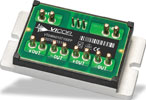
A simplified schematic of a sine amplitude converter is shown in Figure 2. The power train is a low-charge, high-frequency controlled oscillator, with high spectral purity and common-mode symmetry, resulting in essentially noise-free operation. The control architecture locks the operating frequency to the power train resonant frequency, optimising efficiency and minimising output impedance by effectively cancelling reactive components. ROUT can be as low as 0,8 μΩ from a single VTM. If that is not low enough, or if more power is required, VTMs can be paralleled with accurate current sharing. Quiet and powerful, the SAC-based VTM can be considered as a linear voltage/current converter with a flat output impedance up to about 1 MHz.
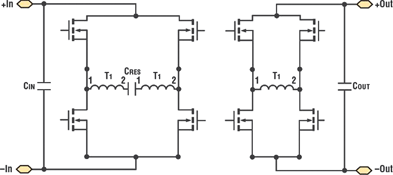
The secondary current in an SAC VTM is basically a pure sinusoid. Selected SAC VTM operating waveforms (Figure 3) show the purity, low output impedance and fast response of a typical VTM. Note also that the time scale in Figure 4a is only 200 nanoseconds per division and that the waveform in Figure 4a is with no external output capacitance across the load. The very low, non-inductive output impedance of the VTM allows an almost instantaneous response to the 100% step change in load current of Figure 4b. Because there is no internal regulation circuitry in a VTM, and none of the attendant loop delays or stability issues, no internal control action is required to respond to the change in load. The internal ASIC controller simply continues its function of controlling and synchronising the operation of the switches to maintain operation at resonance.
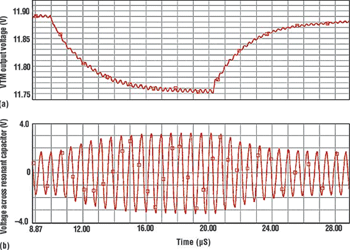
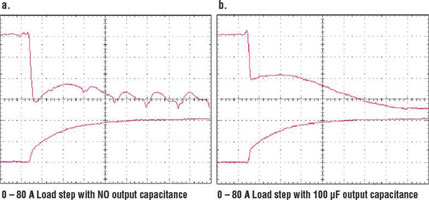
<b?VI BRICK VTM – transformation and isolation</b>
The VTM offers speed, density and efficiency levels designed to meet the demands of DSP, FPGA, ASIC, processor cores and microprocessor applications at the point of load, while providing isolation from input to output. Its response time is less than 1 μs, and it delivers up to 100 A with very high efficiency. The VI BRICK VTM can be considered a fixed-ratio DC-DC transformer with the following capabilities:
* Input range compatible with 48 V and 24 V PRMs.
* Power up to 300 W or 100 A.
* Power density up to 23,4 W/cm³.
* Efficiency up to 97%.
* Isolation to 2250 V d.c. in 13,4 cm² package.
* Low power dissipation at point of load.
* Low output impedance enabling fast transient response.
For DC-DC power conversion, the VTM is designed to operate with the PRM (see next section), which provides soft start, regulation, and the initial VCC pulse at startup. This pulse is received through the VTM control (VC) pin. Standalone VTM operation is possible if a VCC is available.
VI BRICK PRM (pre-regulator module): an efficient buck-boost regulator
The VI BRICK PRM shown in Figure 5 uses a patented ZVS buck-boost regulator control architecture (see Figure 6) to give high efficiency step-up/step-down voltage regulation. Efficiency is maximised when the output voltage is close to the input voltage. The PRM operates at a typical fixed operating frequency of 1 MHz (1,5 MHz maximum). Like VTMs, PRMs may be paralleled to achieve increased output power. A unique feature of the PRM control architecture is that the switching sequence does not change in either buck or boost mode – only the relative duration of phases within an operating cycle need be controlled.
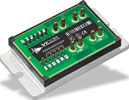
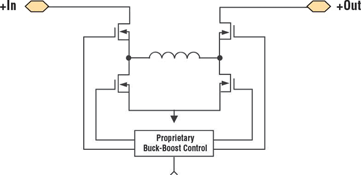
The PRM provides a regulated output voltage – a ‘factorised bus’ – from an unregulated input source. The combination of the PRM and VTM creates an isolated, regulated DC-DC converter. PRMs can also be used standalone as non-isolated voltage regulators. The VI BRICK PRM has the following attributes:
* Input ranges of 18–36 V and 36–75 V.
* Power up to 320 W.
* Power density up to 25,4 W/cm³.
* Efficiency up to 97%.
* 1,5 MHz switching frequency.
* Up to 100°C baseplate operation.
VI BRICK PRM+VTM architectures and applications
The PRM control system and supporting ASICs enable the VTM output voltage to be controlled using a choice of methods. Local loop control is the simplest control scheme. Under local loop control, illustrated in Figure 7, the PRM senses its own output voltage and regulates the factorised bus voltage to a constant value. Load voltage will exhibit a ‘droop’ proportional to the VTM output resistance.

Under adaptive loop control, illustrated in Figure 8, the VTM sends a signal back to the PRM to enable the PRM to adjust the factorised bus voltage to compensate for the VTM output resistance. Adaptive loop control provides improved regulation over simple local loop control – within ±1% – yet requires only a simple, non-isolated feedback connection between the VTM and PRM.

Under remote loop control, illustrated in Figure 9, the voltage at the load is sensed and fed back to the PRM. This feedback protocol provides the most accurate load regulation – within ±0,2% – but may require isolation in the feedback path. With the addition of a (PI1004) Picor point-of-load IC, remote loop control can incorporate a digital control option compatible with the latest processor VID specifications.

<b?VI BRICK BCM (bus converter module): intermediate bus conversion</b>
The VI BRICK BCM (Figure 10), also a sine amplitude converter, provides an isolated intermediate bus voltage to power non-isolated POL converters from a narrow-input-range DC source to maximise power conversion. The BCM functions as a fixed-ratio DC-DC transformer with the following characteristics:
* 48 V and higher voltage input ranges (350 and 384 V)
* Power up to 300 W or 90 A.
* Power density up to 23,4 W/cm³.
* Efficiency up to 97%.
* Lightweight at 31,3 grams.
* Isolation to 4242 V d.c. in a 13,4 cm² package.

The BCM may be used to power non-isolated POL converters or as an independent DC source. Due to its fast response time and low noise, the need for limited life aluminium electrolytic or tantalum capacitors is reduced – or eliminated – resulting in savings of board area, materials and total system cost. BCMs inherently support current-sharing, which allows parallel operation without additional control circuitry or interconnects.
High power-density BCMs that minimise total system capacitance when used as a bus converter enable dense IBA systems (see Figure 11). BCMs are also available with high-voltage input capabilities for high-density DC-DC conversion, typically following a PFC stage in offline AC-DC conversion down to 48 V or 12 V.
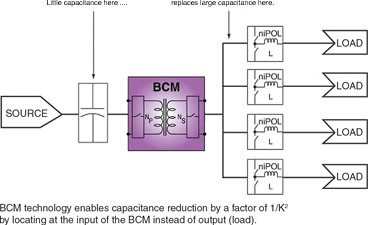
Using FPA: why factorise?
V·I Chips are both very small and very power dense. VI BRICKs, which are based on V·I Chips, are also highly efficient and utilise advanced packaging to facilitate thermal management, mounting and soldering operations. Either can be used as building blocks to replace existing circuits (quarter bricks and silver box power supplies). Factorised power means more space at the point(s) of load: half of the power dissipation and the regulation function can be remotely located.
Flexibility — more options for designing a power system
One of the key objectives of factorised power and VI BRICKs is to increase power system flexibility. In DPA, DC-DC converters bundle the three classic converter functions (isolation, transformation and regulation) into bricks that are no longer adequate in terms of performance or cost-effectiveness. In IBA, non-isolated POL converters forego isolation and high-ratio voltage transformation to improve cost-effectiveness. But they depend upon a nearby bus converter to supply power at a low input voltage and expose over-voltage sensitive loads to deadly faults and ground loops.
Families of VI BRICK BCMs, VTMs and PRMs, optimised for different nominal input and output voltages, and packaged for power capabilities, provide power system designers with a stable of power conversion components that can be used to economically solve a virtually limitless variety of power conversion problems. Complex systems can use combinations of VI BRICKs in a variety of control modes to rapidly configure high-density, low-profile solutions that minimise the need for external components, are cost-effective and highly efficient, and provide state-of-the-art performance.
VI BRICKs provide isolation and regulation where they are needed. A designer can put the VTM at the point of load and the PRM alongside or remotely, in the backplane or on a daughter card. FPA systems with a multiplicity of input and output voltages may actually have fewer unique components compared to a brick-based equivalent. With the VTM, the same device is used no matter what the input voltage; with the PRM the same device is used no matter what the output voltage. A continuum of output voltages is available. New systems can be designed with PRMs and VTMs or existing architectures can be retrofitted. Figures 12, 13, 14 and 15 illustrate a few of the design options.
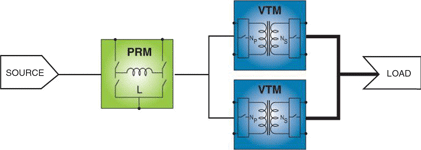
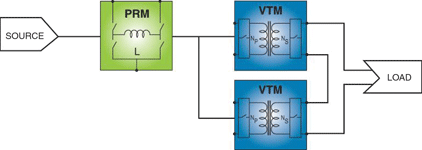
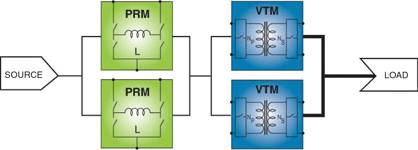
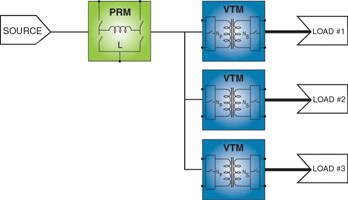
Efficiency — more power for the load, less heat left behind
Both the VI BRICK PRM and VTM can achieve higher than 97% efficiency. Overall efficiency for a power system – including the combination of a PRM and a VTM – operating from an unregulated DC source and supplying a low-voltage DC output typically ranges from 90% to 95%. In many cases, it is possible to achieve overall efficiency exceeding 95% even at full load. With higher efficiency comes lower total heat dissipation, another important consideration in power systems design. VI BRICKs offer flexible thermal management: a low thermal impedance package and the design of the VI BRICK package simplify heatsink design and thermal management.
Fast Transient Response — providing more power for fast changing loads
Many of today’s loads require not only higher current but faster transient response. VTMs respond to load changes, regardless of magnitude, in less than one microsecond with an effective switching frequency of 3,5 MHz – see Figure 16. The VTM’s high bandwidth obsoletes the need for massive point-of-load bypass capacitance. Even without any external output capacitors, the output of a VTM exhibits a limited voltage perturbation in response to a sudden power surge. A minimal amount of external bypass capacitance, in the form of low ESR/ESL ceramic capacitors, suffices to eliminate any transient voltage overshoot.
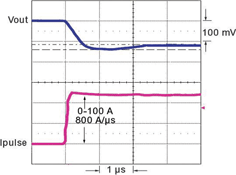
Architecture — IBA, niPOLs and VI BRICKs
IBA has proven effective as an interim method of containing power system cost while addressing the trend toward a proliferation of lower load voltages. IBA relies on non-isolated point-of-load regulators (niPOLs), reducing the POL function to regulation and transformation. The niPOLs operate from an intermediate bus voltage provided by upstream isolated converters. However, traditional IBA has inherent limitations that require trade-offs between distribution and conversion loss and that limit responsiveness to rapid load changes. VI BRICK BCMs can be used to solve these problems and several others.
© Technews Publishing (Pty) Ltd | All Rights Reserved